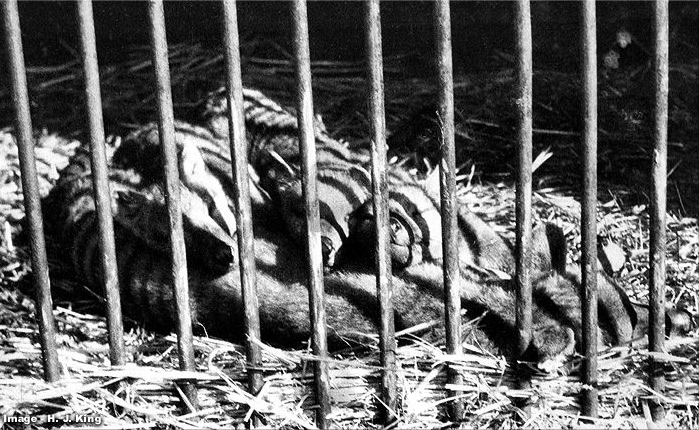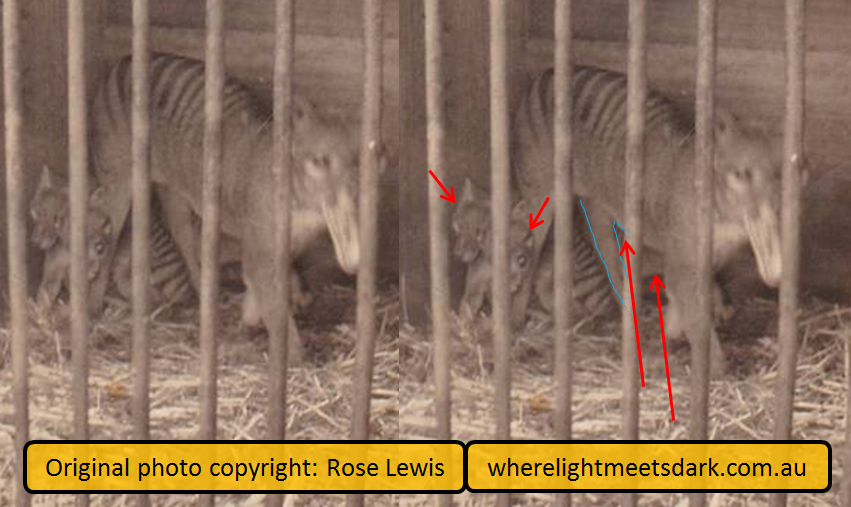Mullins family group - new photo discovered
The "Mullins family group" of thylacines is described in the online Thylacine Museum as having been caught by Walter Mullins in the Florentine Valley in June 1923. They were displayed in a cart before being sold to the zoo in Hobart.
There is one photo by H. J. King given at the online museum, as seen here:
Photo: Mullins family group of thylacines. Photo: H. J. King. Source: Online Thylacine Museum.
On 27 April 2017, Rose Lewis made a post to a Facebook group named Vintage and Retro Australia. In it she explained that her grandfather - Walter John Mullins - took a photo of the last Tasmanian tigers. While the Online Thylacine Museum article goes on to clarify that the Mullins group likely did not include the last known thylacine, for many years this was not clear.
Regardless of the origin of the last known surviving Tasmanian tiger, this newly discovered photo is both incredibly important and noteworthy. Although the animals are captive, very few photographs of living thylacines outside zoos exist and this photo adds to an existing body of knowledge about a specific family group.
On being made aware of the significance of this photo via comments against her post, Rose wrote "Wow, Thank's so much for sharing the history of this photo though it does show grandfather in a rather different light to me now! Just, Wow!"
This discovery will undoubtedly trigger further research into the history of this incredibly important photograph.
Photo: Tasmanian tiger family. Photo: Walter Mullins. Copyright: Rose Lewis.
This image was removed from WLMD between 8 May 2017 and 31 Dec 2017 on request of Rose Lewis. It has been republished under the defence of Fair Dealing under Australian copyright law and is presented as hosted on the ABC News website. For full details on how WLMD respects and supports copyright, please refer to the Terms and conditions of use.
One thing immediately visible is the incredibly wide gape of the mother's mouth. Its protective instinct appears evident by the way in which its young are cowering behind her.
In the photo taken by H. J. King, the young animals appear more mature than those in the photo by Mullins himself. Likely the Mullins photo was taken very soon after the time of capture. In the Mullins photo all three animals are cowering in a rear corner of the transport cage while by the time of King's photo they lazily sleep near the bars at front.
While three young are clearly visible in King's photo, they are not all as apparent in Mullins' photo. However, I do believe they are all present, per the illustration below.
Illustration: Analysis of Tasmanian tiger family group photo. Original photo copyright: Rose Lewis. Composite analysis illustration copyright: Chris Rehberg / Where Light Meets Dark. Original photo source: Facebook.
This image was removed from WLMD between 8 May 2017 and 31 Dec 2017 on request of Rose Lewis. It has been republished under the defence of Fair Dealing under Australian copyright law and is presented as hosted on the ABC News website. For full details on how WLMD respects and supports copyright, please refer to the Terms and conditions of use.
The thin blue lines trace the back leg and stomach of the mother. Between these can be seen three stripes, as indicated by the first long red arrow. The second long red arrow seems to show a portion of the same cub's body. I believe these three stripes are not related to the two other cubs that are easily seen and indicated by the two short red arrows.
The presence of three cubs, relationship of Rose Lewis to Walter Mullins and known history of the Mullins family group all suggest this photo is indeed of the Mullins family group soon after their capture in June 1923.
Do you have old family records of the thylacine?


